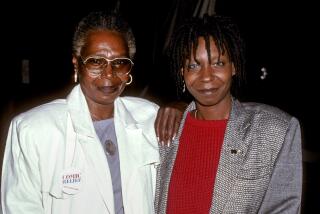‘Art of Rube Goldberg’ more than crazy contraptions
- Share via
I left “The Art of Rube Goldberg” on the kitchen table one morning to see if my 8-year-old would take the bait. It wasn’t long before she was pulling the book closer to study the cartoonist’s cockeyed, unnecessarily elaborate contraptions. Then she drew some of her own.
Goldberg’s inventive designs are perfect spark plugs for the imagination. They turn mundane activities like squeezing orange juice or mailing a letter into long, silly chains of improbable cause and effect. In Goldberg’s universe, the simple act of swatting a fly might require a bottle of carbolic acid, a bean shooter, a tub of syrup, a live trout and a baseball bat, among other things.
Edited by the artist’s granddaughter, Jennifer George, “The Art of Rube Goldberg” is a fitting tribute to this master of absurdist excess. The super-sized tome is stuffed with a dizzying array of reproductions: myriad newspaper cartoons, artwork, photographs and documents from an incredibly prolific career that spanned most of the 20th century. Interspersed with essays that run the gamut from art historical to personal, they provide a rich, detailed picture of Goldberg’s remarkable work and life.
The book kicks off with an insightful introduction by New Yorker writer Adam Gopnik, who brings Goldberg unexpectedly into the orbit of modern art. He compares the artist’s mechanical follies to the absurdist machines of European contemporaries Marcel Duchamp and the Dadaists. Seen in this light, Goldberg’s fascination with mechanization is not just a goof, but an implicit critique of the industrial age. Like the best satirists, he uncovered our obsession with machines by pushing them to ridiculous extremes.
He also mocked our desire for order, painstakingly annotating his devices like step-by-step instructional diagrams. “This taste for process,” writes Gopnik, “is part of the early modern condition, and part of his satiric point is to mock not just the intricacy of machines but the larger idea of efficiency.”
Although the invention drawings are his best-loved creations — earning his name a spot in the dictionary as an adjective, no less — these were only one strand of Goldberg’s multi-faceted career. Lampooning machine-mania was part of his larger project as an astute observer of human foibles.
One of his earliest successes, from 1908, was “Foolish Questions,” a series of single-panel cartoons that poked fun at our penchant for asking questions with obvious answers. This was followed by the pun-heavy “I’m the Guy,” which spawned souvenir buttons, cigarette cards and a hit song with lines like “I’m the guy who put the hobo in Hoboken.” Other recurring titles reveal Goldberg’s interest in life’s little absurdities: “They All Look Good When They’re Far Away,” “Life’s Little Jokes,” and “It’s Wrong … All Wrong.”
After a short-lived flirtation with animated newsreels in 1916, Goldberg developed the long-running comic strip “Boob McNutt,” about a lovable fall guy confronted with all manner of crazy, fantastical situations. But Goldberg never quite hit his stride with the serial strip form that became popular in the 1930s. In 1938 he moved into editorial and political cartooning, winning a Pulitzer Prize 10 years later for the anti-nuclear cartoon “Peace Today.”
The charm and blunt humor of Goldberg’s early single-panel works may seem naïve by today’s snarky standards, but his cartoons still feel surprisingly resonant. He even seems to have anticipated our video-addled age, inventing a bulky “portable-movie-talkie camera.” Carried on the back, it has a lens that extends like a periscope overhead to film everything in one’s path.
Viewed in 2013, in the thick of the digital revolution, Goldberg’s patently ridiculous inventions remind us to shake off technology’s grip every now and then and have a laugh at our own expense.
Mizota is a writer in Los Angeles.
The Art of Rube Goldberg
Rube Goldberg, edited by Jennifer George
Abrams ComicArts: 192 pp., $60
More to Read
Sign up for our Book Club newsletter
Get the latest news, events and more from the Los Angeles Times Book Club, and help us get L.A. reading and talking.
You may occasionally receive promotional content from the Los Angeles Times.









